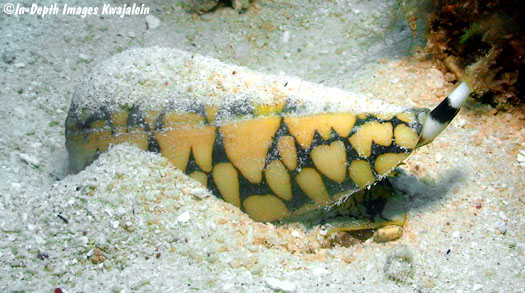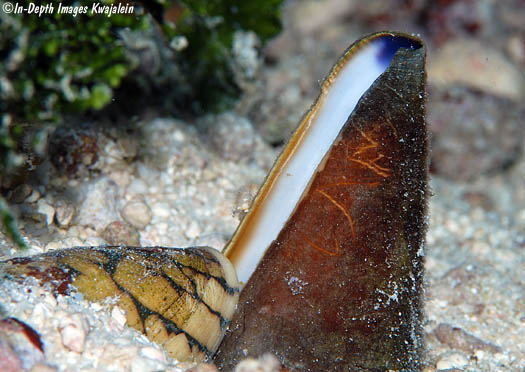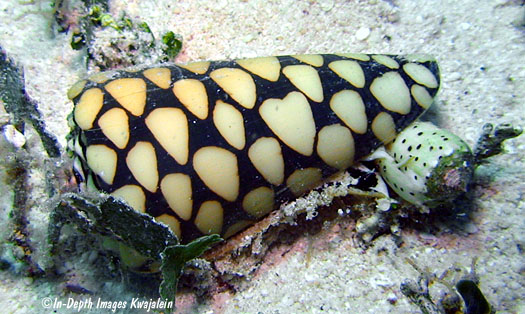Nutrition & Uptake
 As described on the Adaptation page,
Conus marmoreus and all the other cone snails have adapted
an altered radular tooth. To catch its prey off guard, the
marbled cone buries itself into the sandy substrate with only
its siphon sticking out to detect prey. When prey is near and
this modified radular tooth is in position to be shot, the
muscular poison bulb at the end of the venom bulb contracts. The
resulting pressure shoots the harpoon out of the proboscis and
into its prey, followed by a cloud of poison. Molluscivores
(mollusk eaters) such as C. marmoreus may use several
harpoons in succession, and the poison is exuded through a canal
in the tooth. Watch the video below to see exactly how it
takes down its prey (pay close attention to 0:49 to see the
cloud of poison; video courtesy of
Dr. Jason Biggs).
As described on the Adaptation page,
Conus marmoreus and all the other cone snails have adapted
an altered radular tooth. To catch its prey off guard, the
marbled cone buries itself into the sandy substrate with only
its siphon sticking out to detect prey. When prey is near and
this modified radular tooth is in position to be shot, the
muscular poison bulb at the end of the venom bulb contracts. The
resulting pressure shoots the harpoon out of the proboscis and
into its prey, followed by a cloud of poison. Molluscivores
(mollusk eaters) such as C. marmoreus may use several
harpoons in succession, and the poison is exuded through a canal
in the tooth. Watch the video below to see exactly how it
takes down its prey (pay close attention to 0:49 to see the
cloud of poison; video courtesy of
Dr. Jason Biggs).
Because mollusk prey can’t escape as quickly as fish, there is
no need for the molluscivores to hold on to their prey after
they have harpooned them, as piscivores (fish eaters) do. If
its prey has a thin shell, the marbled cone snail will ingest
the whole shell; however, if the
 shell is too thick, it will
hold its mouth against the prey’s opening and will suck out the
snail inside (shown left). When its prey is ingested, the tooth is swallowed
whole as well, and a new one is moved into the base of the
proboscis for a future attack. The poison used by C.
marmoreus is ingested along with the prey, but has no
effect on the snail itself. More information on this
poison can be found here. There are no distinct
shell differences between deadly fish-feeding species and
less-extreme worm eating species of carnivorous snails, so one
should be very careful when collecting or examining shells.
shell is too thick, it will
hold its mouth against the prey’s opening and will suck out the
snail inside (shown left). When its prey is ingested, the tooth is swallowed
whole as well, and a new one is moved into the base of the
proboscis for a future attack. The poison used by C.
marmoreus is ingested along with the prey, but has no
effect on the snail itself. More information on this
poison can be found here. There are no distinct
shell differences between deadly fish-feeding species and
less-extreme worm eating species of carnivorous snails, so one
should be very careful when collecting or examining shells.
 In order to get nutrients cycled throughout its body, C.
marmoreus utilizes what is called an open circulatory
system. In this system, organs are bathed with transport fluid,
instead of being confined to blood vessels like in closed
circulatory systems. The transport fluid is hemolymph, which is
made up of blood and interstitial fluid. It also contains
hemocytes, which function as a form of defense to antigens, and
uses hemocyanin as an oxygen carrier instead of hemoglobin. An
open circulatory system favors organisms with a sedentary
lifestyle and low oxygen demands since it has low vessel
pressures, which perfectly describes the marbled cone snail.
In order to get nutrients cycled throughout its body, C.
marmoreus utilizes what is called an open circulatory
system. In this system, organs are bathed with transport fluid,
instead of being confined to blood vessels like in closed
circulatory systems. The transport fluid is hemolymph, which is
made up of blood and interstitial fluid. It also contains
hemocytes, which function as a form of defense to antigens, and
uses hemocyanin as an oxygen carrier instead of hemoglobin. An
open circulatory system favors organisms with a sedentary
lifestyle and low oxygen demands since it has low vessel
pressures, which perfectly describes the marbled cone snail.
Continue to Reproduction
Return to Home
Visit MultipleOrganisms.net
Visit the UW-La
Crosse Website
Contact Information